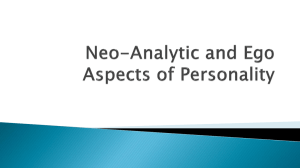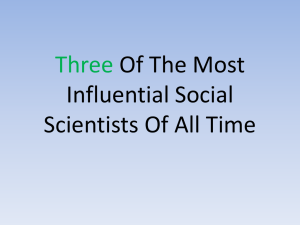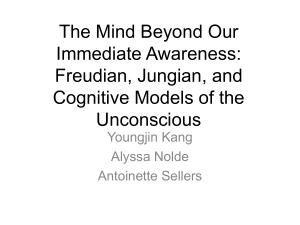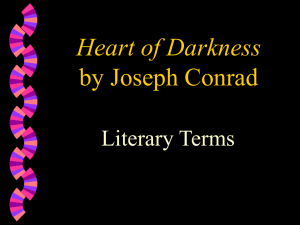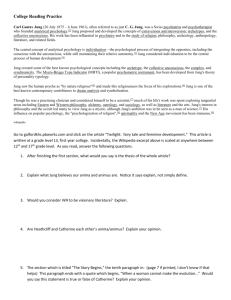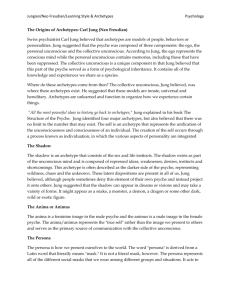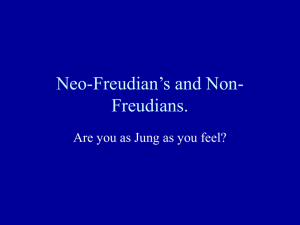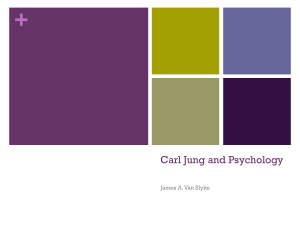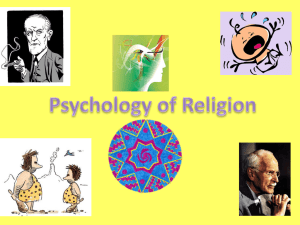CARL G JUNG
advertisement
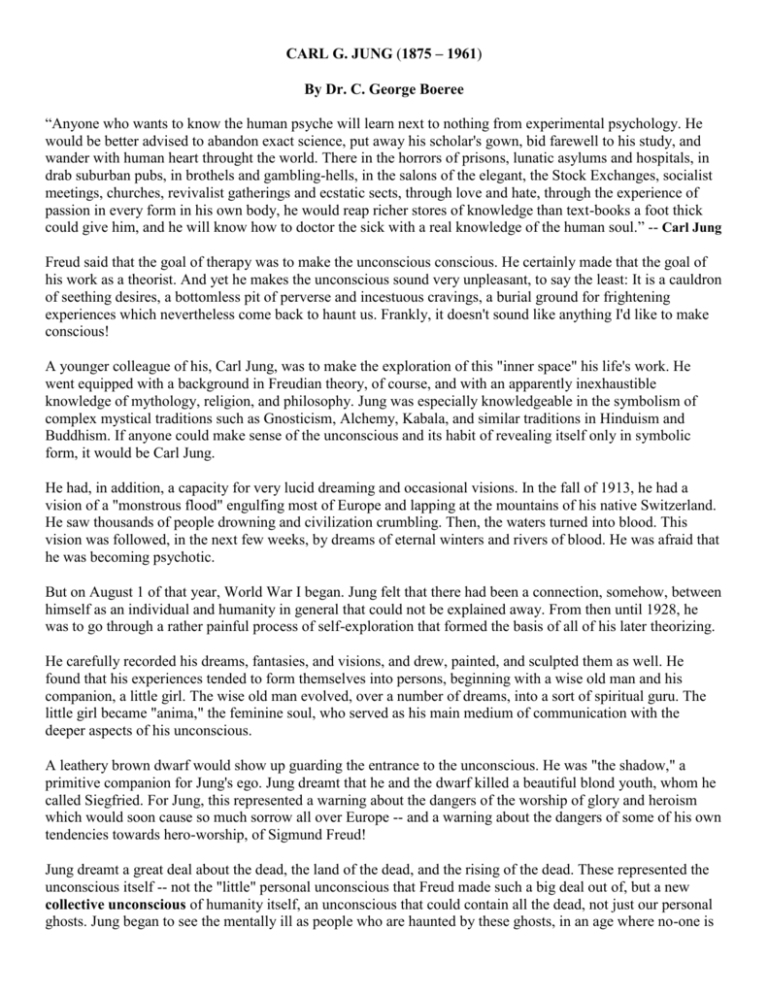
CARL G. JUNG (1875 – 1961) By Dr. C. George Boeree “Anyone who wants to know the human psyche will learn next to nothing from experimental psychology. He would be better advised to abandon exact science, put away his scholar's gown, bid farewell to his study, and wander with human heart throught the world. There in the horrors of prisons, lunatic asylums and hospitals, in drab suburban pubs, in brothels and gambling-hells, in the salons of the elegant, the Stock Exchanges, socialist meetings, churches, revivalist gatherings and ecstatic sects, through love and hate, through the experience of passion in every form in his own body, he would reap richer stores of knowledge than text-books a foot thick could give him, and he will know how to doctor the sick with a real knowledge of the human soul.” -- Carl Jung Freud said that the goal of therapy was to make the unconscious conscious. He certainly made that the goal of his work as a theorist. And yet he makes the unconscious sound very unpleasant, to say the least: It is a cauldron of seething desires, a bottomless pit of perverse and incestuous cravings, a burial ground for frightening experiences which nevertheless come back to haunt us. Frankly, it doesn't sound like anything I'd like to make conscious! A younger colleague of his, Carl Jung, was to make the exploration of this "inner space" his life's work. He went equipped with a background in Freudian theory, of course, and with an apparently inexhaustible knowledge of mythology, religion, and philosophy. Jung was especially knowledgeable in the symbolism of complex mystical traditions such as Gnosticism, Alchemy, Kabala, and similar traditions in Hinduism and Buddhism. If anyone could make sense of the unconscious and its habit of revealing itself only in symbolic form, it would be Carl Jung. He had, in addition, a capacity for very lucid dreaming and occasional visions. In the fall of 1913, he had a vision of a "monstrous flood" engulfing most of Europe and lapping at the mountains of his native Switzerland. He saw thousands of people drowning and civilization crumbling. Then, the waters turned into blood. This vision was followed, in the next few weeks, by dreams of eternal winters and rivers of blood. He was afraid that he was becoming psychotic. But on August 1 of that year, World War I began. Jung felt that there had been a connection, somehow, between himself as an individual and humanity in general that could not be explained away. From then until 1928, he was to go through a rather painful process of self-exploration that formed the basis of all of his later theorizing. He carefully recorded his dreams, fantasies, and visions, and drew, painted, and sculpted them as well. He found that his experiences tended to form themselves into persons, beginning with a wise old man and his companion, a little girl. The wise old man evolved, over a number of dreams, into a sort of spiritual guru. The little girl became "anima," the feminine soul, who served as his main medium of communication with the deeper aspects of his unconscious. A leathery brown dwarf would show up guarding the entrance to the unconscious. He was "the shadow," a primitive companion for Jung's ego. Jung dreamt that he and the dwarf killed a beautiful blond youth, whom he called Siegfried. For Jung, this represented a warning about the dangers of the worship of glory and heroism which would soon cause so much sorrow all over Europe -- and a warning about the dangers of some of his own tendencies towards hero-worship, of Sigmund Freud! Jung dreamt a great deal about the dead, the land of the dead, and the rising of the dead. These represented the unconscious itself -- not the "little" personal unconscious that Freud made such a big deal out of, but a new collective unconscious of humanity itself, an unconscious that could contain all the dead, not just our personal ghosts. Jung began to see the mentally ill as people who are haunted by these ghosts, in an age where no-one is supposed to even believe in them. If we could only recapture our mythologies, we would understand these ghosts, become comfortable with the dead, and heal our mental illnesses. Critics have suggested that Jung was, very simply, ill himself when all this happened. But Jung felt that, if you want to understand the jungle, you can't be content just to sail back and forth near the shore. You've got to get into it, no matter how strange and frightening it might seem. Biography Carl Gustav Jung was born July 26, 1875, in the small Swiss village of Kessewil. His father was Paul Jung, a country parson, and his mother was Emilie Preiswerk Jung. He was surrounded by a fairly well educated extended family, including quite a few clergymen and some eccentrics as well. The elder Jung started Carl on Latin when he was six years old, beginning a long interest in language and literature -- especially ancient literature. Besides most modern western European languages, Jung could read several ancient ones, including Sanskrit, the language of the original Hindu holy books. Carl was a rather solitary adolescent, who didn't care much for school, and especially couldn't take competition. He went to boarding school in Basel, Switzerland, where he found himself the object of a lot of jealous harassment. He began to use sickness as an excuse, developing an embarrassing tendency to faint under pressure. Although his first career choice was archeology, he went on to study medicine at the University of Basel. While working under the famous neurologist Krafft-Ebing, he settled on psychiatry as his career. After graduating, he took a position at the Burghoeltzli Mental Hospital in Zurich under Eugene Bleuler, an expert on (and the namer of) schizophrenia. In 1903, he married Emma Rauschenbach. He also taught classes at the University of Zurich, had a private practice, and invented word association at this time! Long an admirer of Freud, he met him in Vienna in 1907. The story goes that after they met, Freud canceled all his appointments for the day, and they talked for 13 hours straight, such was the impact of the meeting of these two great minds! Freud eventually came to see Jung as the crown prince of psychoanalysis and his heir apparent. But Jung had never been entirely sold on Freud's theory. Their relationship began to cool in 1909, during a trip to America. They were entertaining themselves by analyzing each other’s' dreams (more fun, apparently, than shuffleboard), when Freud seemed to show an excess of resistance to Jung's efforts at analysis. Freud finally said that they'd have to stop because he was afraid he would lose his authority! Jung felt rather insulted. World War I was a painful period of self-examination for Jung. It was, however, also the beginning of one of the most interesting theories of personality the world has ever seen. After the war, Jung traveled widely, visiting, for example, tribal people in Africa, America, and India. He retired in 1946, and began to retreat from public attention after his wife died in 1955. He died on June 6, 1961, in Zurich. Theory Jung's theory divides the psyche into three parts. The first is the ego, which Jung identifies with the conscious mind. Closely related is the personal unconscious, which includes anything which is not presently conscious, but can be. The personal unconscious is like most people's understanding of the unconscious in that it includes both memories that are easily brought to mind and those that have been suppressed for some reason. But it does not include the instincts that Freud would have it include. But then Jung adds the part of the psyche that makes his theory stand out from all others: the collective unconscious. You could call it your "psychic inheritance." It is the reservoir of our experiences as a species, a kind of knowledge we are all born with. And yet we can never be directly conscious of it. It influences all of our experiences and behaviors, most especially the emotional ones, but we only know about it indirectly, by looking at those influences. There are some experiences that show the effects of the collective unconscious more clearly than others: The experiences of love at first sight, of deja vu (the feeling that you've been here before), and the immediate recognition of certain symbols and the meanings of certain myths, could all be understood as the sudden conjunction of our outer reality and the inner reality of the collective unconscious. Grander examples are the creative experiences shared by artists and musicians all over the world and in all times, or the spiritual experiences of mystics of all religions, or the parallels in dreams, fantasies, mythologies, fairy tales, and literature. A nice example that has been greatly discussed recently is the near-death experience. It seems that many people, of many different cultural backgrounds, find that they have very similar recollections when they are brought back from a close encounter with death. They speak of leaving their bodies, seeing their bodies and the events surrounding them clearly, of being pulled through a long tunnel towards a bright light, of seeing deceased relatives or religious figures waiting for them, and of their disappointment at having to leave this happy scene to return to their bodies. Perhaps we are all "built" to experience death in this fashion. Archetypes The contents of the collective unconscious are called archetypes. Jung also called them dominants, imagos, mythological or primordial images, and a few other names, but archetypes seems to have won out over these. An archetype is an unlearned tendency to experience things in a certain way. The archetype has no form of its own, but it acts as an "organizing principle" on the things we see or do. It works the way that instincts work in Freud's theory: At first, the baby just wants something to eat, without knowing what it wants. It has a rather indefinite yearning which, nevertheless, can be satisfied by some things and not by others. Later, with experience, the child begins to yearn for something more specific when it is hungry -- a bottle, a cookie, a broiled lobster, a slice of New York style pizza. The archetype is like a black hole in space: You only know it is there by how it draws matter and light to itself. The mother archetype The mother archetype is a particularly good example. All of our ancestors had mothers. We have evolved in an environment that included a mother or mothersubstitute. We would never have survived without our connection with a nurturing-one during our times as helpless infants. It stands to reason that we are "built" in a way that reflects that evolutionary environment: We come into this world ready to want mother, to seek her, to recognize her, to deal with her. So the mother archetype is our built-in ability to recognize a certain relationship, that of "mothering." Jung says that this is rather abstract, and we are likely to project the archetype out into the world and onto a particular person, usually our own mothers. Even when an archetype doesn't have a particular real person available, we tend to personify the archetype, that is, turn it into a mythological "story-book" character. This character symbolizes the archetype. The mother archetype is symbolized by the primordial mother or "earth mother" of mythology, by Eve and Mary in western traditions, and by less personal symbols such as the church, the nation, a forest, or the ocean. According to Jung, someone whose own mother failed to satisfy the demands of the archetype may well be one that spends his or her life seeking comfort in the church, or in identification with "the motherland," or in meditating upon the figure of Mary, or in a life at sea. Mana You must understand that these archetypes are not really biological things, like Freud's instincts. They are more spiritual demands. For example, if you dreamt about long things, Freud might suggest these things represent the phallus and ultimately sex. But Jung might have a very different interpretation. Even dreaming quite specifically about a penis might not have much to do with some unfulfilled need for sex. It is curious that in primitive societies, phallic symbols do not usually refer to sex at all. They usually symbolize mana, or spiritual power. These symbols would be displayed on occasions when the spirits are being called upon to increase the yield of corn, or fish, or to heal someone. The connection between the penis and strength, between semen and seed, between fertilization and fertility are understood by most cultures. The shadow Sex and the life instincts in general are, of course, represented somewhere in Jung's system. They are a part of an archetype called the shadow. It derives from our prehuman, animal past, when our concerns were limited to survival and reproduction, and when we weren't self-conscious. It is the "dark side" of the ego, and the evil that we are capable of is often stored there. Actually, the shadow is amoral -- neither good nor bad, just like animals. An animal is capable of tender care for its young and vicious killing for food, but it doesn't choose to do either. It just does what it does. It is "innocent." But from our human perspective, the animal world looks rather brutal, inhuman, so the shadow becomes something of a garbage can for the parts of ourselves that we can't quite admit to. Symbols of the shadow include the snake (as in the garden of Eden), the dragon, monsters, and demons. It often guards the entrance to a cave or a pool of water, which is the collective unconscious. Next time you dream about wrestling with the devil, it may only be yourself you are wrestling with! The persona The persona represents your public image. The word is, obviously, related to the word person and personality, and comes from a Latin word for mask. So the persona is the mask you put on before you show yourself to the outside world. Although it begins as an archetype, by the time we are finished realizing it, it is the part of us most distant from the collective unconscious. At its best, it is just the "good impression" we all wish to present as we fill the roles society requires of us. But, of course, it can also be the "false impression" we use to manipulate people's opinions and behaviors. And, at its worst, it can be mistaken, even by ourselves, for our true nature: Sometimes we believe we really are what we pretend to be! Anima and animus A part of our persona is the role of male or female we must play. For most people that role is determined by their physical gender. But Jung, like Freud and Adler and others, felt that we are all really bisexual in nature. When we begin our lives as fetuses, we have undifferentiated sex organs that only gradually, under the influence of hormones, become male or female. Likewise, when we begin our social lives as infants, we are neither male nor female in the social sense. Almost immediately -- as soon as those pink or blue booties go on -we come under the influence of society, which gradually molds us into men and women. In all societies, the expectations placed on men and women differ, usually based on our different roles in reproduction, but often involving many details that are purely traditional. In our society today, we still have many remnants of these traditional expectations. Women are still expected to be more nurturant and less aggressive; men are still expected to be strong and to ignore the emotional side of life. But Jung felt these expectations meant that we had developed only half of our potential. The anima is the female aspect present in the collective unconscious of men, and the animus is the male aspect present in the collective unconscious of women. Together, they are refered to as syzygy. The anima may be personified as a young girl, very spontaneous and intuitive, or as a witch, or as the earth mother. It is likely to be associated with deep emotionality and the force of life itself. The animus may be personified as a wise old man, a sorcerer, or often a number of males, and tends to be logical, often rationalistic, even argumentative. The anima or animus is the archetype through which you communicate with the collective unconscious generally, and it is important to get into touch with it. It is also the archetype that is responsible for much of our love life: We are, as an ancient Greek myth suggests, always looking for our other half, the half that the Gods took from us, in members of the opposite sex. When we fall in love at first sight, then we have found someone that "fills" our anima or animus archetype particularly well! Other archetypes Jung said that there is no fixed number of archetypes which we could simply list and memorize. They overlap and easily melt into each other as needed, and their logic is not the usual kind. But here are some he mentions: Besides mother, their are other family archetypes. Obviously, there is father, who is often symbolized by a guide or an authority figure. There is also the archetype family, which represents the idea of blood relationship and ties that run deeper than those based on conscious reasons. There is also the child, represented in mythology and art by children, infants most especially, as well as other small creatures. The Christ child celebrated at Christmas is a manifestation of the child archetype, and represents the future, becoming, rebirth, and salvation. Curiously, Christmas falls during the winter solstice, which in northern primitive cultures also represents the future and rebirth. People used to light bonfires and perform ceremonies to encourage the sun's return to them. The child archetype often blends with other archetypes to form the child-god, or the child-hero. Many archetypes are story characters. The hero is one of the main ones. He is the mana personality and the defeater of evil dragons. Basically, he represents the ego -- we do tend to identify with the hero of the story -and is often engaged in fighting the shadow, in the form of dragons and other monsters. The hero is, however, often dumb as a post. He is, after all, ignorant of the ways of the collective unconscious. Luke Skywalker, in the Star Wars films, is the perfect example of a hero. The hero is often out to rescue the maiden. She represents purity, innocence, and, in all likelihood, naiveté. In the beginning of the Star Wars story, Princess Leia is the maiden. But, as the story progresses, she becomes the anima, discovering the powers of the force -- the collective unconscious -- and becoming an equal partner with Luke, who turns out to be her brother. The hero is guided by the wise old man. He is a form of the animus, and reveals to the hero the nature of the collective unconscious. In Star Wars, he is played by Obi Wan Kenobi and, later, Yoda. Notice that they teach Luke about the force and, as Luke matures, they die and become a part of him. You might be curious as to the archetype represented by Darth Vader, the "dark father." He is the shadow and the master of the dark side of the force. He also turns out to be Luke and Leia's father. When he dies, he becomes one of the wise old men. There is also an animal archetype, representing humanity's relationships with the animal world. The hero's faithful horse would be an example. Snakes are often symbolic of the animal archetype, and are thought to be particularly wise. Animals, after all, are more in touch with their natures than we are. Perhaps loyal little robots and reliable old spaceships -- the Falcon-- are also symbols of animal. And there is the trickster, often represented by a clown or a magician. The trickster's role is to hamper the hero's progress and to generally make trouble. In Norse mythology, many of the gods' adventures originate in some trick or another played on their majesties by the half-god Loki. There are other archetypes that are a little more difficult to talk about. One is the original man, represented in western religion by Adam. Another is the God archetype, representing our need to comprehend the universe, to give a meaning to all that happens, to see it all as having some purpose and direction. The hermaphrodite, both male and female, represents the union of opposites, an important idea in Jung's theory. In some religious art, Jesus is presented as a rather feminine man. Likewise, in China, the character Kuan Yin began as a male saint (the bodhisattva Avalokiteshwara), but was portrayed in such a feminine manner that he is more often thought of as the female goddess of compassion! The most important archetype of all is the self. The self is the ultimate unity of the personality and is symbolized by the circle, the cross, and the mandala figures that Jung was fond of painting. A mandala is a drawing that is used in meditation because it tends to draw your focus back to the center, and it can be as simple as a geometric figure or as complicated as a stained glass window. The personifications that best represent self are Christ and Buddha, two people who many believe achieved perfection. But Jung felt that perfection of the personality is only truly achieved in death. The dynamics of the psyche So much for the content of the psyche. Now let's turn to the principles of its operation. Jung gives us three principles, beginning with the principle of opposites. Every wish immediately suggests its opposite. If I have a good thought, for example, I cannot help but have in me somewhere the opposite bad thought. In fact, it is a very basic point: In order to have a concept of good, you must have a concept of bad, just like you can't have up without down or black without white. This idea came home to me when I was about eleven. I occasionally tried to help poor innocent woodland creatures who had been hurt in some way -- often, I'm afraid, killing them in the process. Once I tried to nurse a baby robin back to health. But when I picked it up, I was so struck by how light it was that the thought came to me that I could easily crush it in my hand. Mind you, I didn't like the idea, but it was undeniably there. According to Jung, it is the opposition that creates the power (or libido) of the psyche. It is like the two poles of a battery, or the splitting of an atom. It is the contrast that gives energy, so that a strong contrast gives strong energy, and a weak contrast gives weak energy. The second principle is the principle of equivalence. The energy created from the opposition is "given" to both sides equally. So, when I held that baby bird in my hand, there was energy to go ahead and try to help it. But there is an equal amount of energy to go ahead and crush it. I tried to help the bird, so that energy went into the various behaviors involved in helping it. But what happens to the other energy? Well, that depends on your attitude towards the wish that you didn't fulfill. If you acknowledge it, face it, keep it available to the conscious mind, then the energy goes towards a general improvement of your psyche. You grow, in other words. But if you pretend that you never had that evil wish, if you deny and suppress it, the energy will go towards the development of a complex. A complex is a pattern of suppressed thoughts and feelings that cluster -- constellate -- around a theme provided by some archetype. If you deny ever having thought about crushing the little bird, you might put that idea into the form offered by the shadow (your "dark side"). Or if a man denies his emotional side, his emotionality might find its way into the anima archetype. And so on. Here's where the problem comes: If you pretend all your life that you are only good, that you don't even have the capacity to lie and cheat and steal and kill, then all the times when you do good, that other side of you goes into a complex around the shadow. That complex will begin to develop a life of its own, and it will haunt you. You might find yourself having nightmares in which you go around stomping on little baby birds! If it goes on long enough, the complex may take over, may "possess" you, and you might wind up with a multiple personality. In the movie The Three Faces of Eve, Joanne Woodward portrayed a meek, mild woman who eventually discovered that she went out and partied like crazy on Saturday nights. She didn't smoke, but found cigarettes in her purse, didn't drink, but woke up with hangovers, didn't fool around, but found herself in sexy outfits. Although multiple personality is rare, it does tend to involve these kinds of black-and-white extremes. The final principle is the principle of entropy. This is the tendency for oppositions to come together, and so for energy to decrease, over a person's lifetime. Jung borrowed the idea from physics, where entropy refers to the tendency of all physical systems to "run down," that is, for all energy to become evenly distributed. If you have, for example, a heat source in one corner of the room, the whole room will eventually be heated. When we are young, the opposites will tend to be extreme, and so we tend to have lots of energy. For example, adolescents tend to exaggerate male-female differences, with boys trying hard to be macho and girls trying equally hard to be feminine. And so their sexual activity is invested with great amounts of energy! Plus, adolescents often swing from one extreme to another, being wild and crazy one minute and finding religion the next. As we get older, most of us come to be more comfortable with our different facets. We are a bit less naively idealistic and recognize that we are all mixtures of good and bad. We are less threatened by the opposite sex within us and become more androgynous. Even physically, in old age, men and women become more alike. This process of rising above our opposites, of seeing both sides of who we are, is called transcendence. The self The goal of life is to realize the self. The self is an archetype that represents the transcendence of all opposites, so that every aspect of your personality is expressed equally. You are then neither and both male and female, neither and both ego and shadow, neither and both good and bad, neither and both conscious and unconscious, neither and both an individual and the whole of creation. And yet, with no oppositions, there is no energy, and you cease to act. Of course, you no longer need to act. To keep it from getting too mystical, think of it as a new center, a more balanced position, for your psyche. When you are young, you focus on the ego and worry about the trivialities of the persona. When you are older (assuming you have been developing as you should), you focus a little deeper, on the self, and become closer to all people, all life, even the universe itself. The self-realized person is actually less selfish. Synchronicity Personality theorists have argued for many years about whether psychological processes function in terms of mechanism or teleology. Mechanism is the idea that things work in through cause and effect: One thing leads to another which leads to another, and so on, so that the past determines the present. Teleology is the idea that we are lead on by our ideas about a future state, by things like purposes, meanings, values, and so on. Mechanism is linked with determinism and with the natural sciences. Teleology is linked with free will and has become rather rare. It is still common among moral, legal, and religious philosophers, and, of course, among personality theorists. Among the people discussed in this book, Freudians and behaviorists tend to be mechanists, while the neoFreudians, humanists, and existentialists tend to be teleologists. Jung believes that both play a part. But he adds a third alternative called synchronicity. Synchronicity is the occurrence of two events that are neither linked causally, nor linked teleologically, yet are meaningfully related. Once, a client was describing a dream involving a scarab beetle when, at that very instant, a very similar beetle flew into the window. Often, people dream about something, like the death of a loved one, and find the next morning that their loved one did, in fact, die at about that time. Sometimes people pick up he phone to call a friend, only to find that their friend is already on the line. Most psychologists would call these things coincidences, or try to show how they are more likely to occur than we think. Jung believed the were indications of how we are connected, with our fellow humans and with nature in general, through the collective unconscious. Jung was never clear about his own religious beliefs. But this unusual idea of synchronicity is easily explained by the Hindu view of reality. In the Hindu view, our individual egos are like islands in a sea: We look out at the world and each other and think we are separate entities. What we don't see is that we are connected to each other by means of the ocean floor beneath the waters. The outer world is called maya, meaning illusion, and is thought of as God's dream or God's dance. That is, God creates it, but it has no reality of its own. Our individual egos they call jivatman, which means individual souls. But they, too, are something of an illusion. We are all actually extensions of the one and only Atman, or God, who allows bits of himself to forget his identity, to become apparently separate and independent, to become us. But we never truly are separate. When we die, we wake up and realize who we were from the beginning: God. When we dream or meditate, we sink into our personal unconscious, coming closer and closer to our true selves, the collective unconscious. It is in states like this that we are especially open to "communications" from other egos. Synchronicity makes Jung's theory one of the rare ones that is not only compatible with parapsychological phenomena, but actually tries to explain them! Introversion and extroversion Jung developed a personality typology that has become so popular that some people don't realize he did anything else! It begins with the distinction between introversion and extroversion. Introverts are people who prefer their internal world of thoughts, feelings, fantasies, dreams, and so on, while extroverts prefer the external world of things and people and activities. The words have become confused with ideas like shyness and sociability, partially because introverts tend to be shy and extroverts tend to be sociable. But Jung intended for them to refer more to whether you ("ego") more often faced toward the persona and outer reality, or toward the collective unconscious and its archetypes. In that sense, the introvert is somewhat more mature than the extrovert. Our culture, of course, values the extrovert much more. And Jung warned that we all tend to value our own type most! We now find the introvert-extravert dimension in several theories, notably Hans Eysenck's, although often hidden under alternative names such as "sociability" and "surgency." The functions Whether we are introverts or extroverts, we need to deal with the world, inner and outer. And each of us has our preferred ways of dealing with it, ways we are comfortable with and good at. Jung suggests there are four basic ways, or functions: The first is sensing. Sensing means what it says: getting information by means of the senses. A sensing person is good at looking and listening and generally getting to know the world. Jung called this one of the irrational functions, meaning that it involved perception rather than judging of information. The second is thinking. Thinking means evaluating information or ideas rationally, logically. Jung called this a rational function, meaning that it involves decision making or judging, rather than simple intake of information. The third is intuiting. Intuiting is a kind of perception that works outside of the usual conscious processes. It is irrational or perceptual, like sensing, but comes from the complex integration of large amounts of information, rather than simple seeing or hearing. Jung said it was like seeing around corners. The fourth is feeling. Feeling, like thinking, is a matter of evaluating information, this time by weighing one's overall, emotional response. Jung calls it rational, obviously not in the usual sense of the word. We all have these functions. We just have them in different proportions, you might say. Each of us has a superior function, which we prefer and which is best developed in us, a secondary function, which we are aware of and use in support of our superior function, a tertiary function, which is only slightly less developed but not terribly conscious, and an inferior function, which is poorly developed and so unconscious that we might deny its existence in ourselves. Most of us develop only one or two of the functions, but our goal should be to develop all four. Once again, Jung sees the transcendence of opposites as the ideal. Assessment Katharine Briggs and her daughter Isabel Briggs Myers found Jung's types and functions so revealing of people's personalities that they decided to develop a paper-and-pencil test. It came to be called the MyersBriggs Type Indicator, and is one of the most popular, and most studied, tests around. On the basis of your answers on about 125 questions, you are placed in one of sixteen types, with the understanding that some people might find themselves somewhere between two or three types. What type you are says quite a bit about you -- your likes and dislikes, your likely career choices, your compatibility with others, and so on. People tend to like it quite a bit. It has the unusual quality among personality tests of not being too judgmental: None of the types is terribly negative, nor are any overly positive. Rather than assessing how "crazy" you are, the "Myers-Briggs" simply opens up your personality for exploration. The test has four scales. Extroversion - Introversion (E-I) is the most important. Test researchers have found that about 75 % of the population is extroverted. The next one is Sensing - Intuiting (S-N), with about 75 % of the population sensing. The next is Thinking - Feeling (T-F). Although these are distributed evenly through the population, researchers have found that two-thirds of men are thinkers, while two-thirds of women are feelers. This might seem like stereotyping, but keep in mind that feeling and thinking are both valued equally by Jungians, and that one-third of men are feelers and one-third of women are thinkers. Note, though, that society does value thinking and feeling differently, and that feeling men and thinking women often have difficulties dealing with people's stereotyped expectations. The last is Judging - Perceiving (J-P), not one of Jung's original dimensions. Myers and Briggs included this one in order to help determine which of a person's functions is superior. Generally, judging people are more careful, perhaps inhibited, in their lives. Perceiving people tend to be more spontaneous, sometimes careless. If you are an extrovert and a "J," you are a thinker or feeler, whichever is stronger. Extroverted and "P" means you are a senser or intuiter. On the other hand, an introvert with a high "J" score will be a senser or intuiter, while an introvert with a high "P" score will be a thinker or feeler. J and P are equally distributed in the population. Each type is identified by four letters, such as ENFJ. These have proven so popular, you can even find them on people's license plates! ENFJ (Extroverted feeling with intuiting): These people are easy speakers. They tend to idealize their friends. They make good parents, but have a tendency to allow themselves to be used. They make good therapists, teachers, executives, and salespeople. ENFP (Extroverted intuiting with feeling): These people love novelty and surprises. They are big on emotions and expression. They are susceptible to muscle tension and tend to be hyperalert. they tend to feel selfconscious. They are good at sales, advertising, politics, and acting. ENTJ (Extroverted thinking with intuiting): In charge at home, they expect a lot from spouses and kids. They like organization and structure and tend to make good executives and administrators. ENTP (Extroverted intuiting with thinking): These are lively people, not humdrum or orderly. As mates, they are a little dangerous, especially economically. They are good at analysis and make good entrepreneurs. They do tend to play at “oneupmanship.” ESFJ (Extroverted feeling with sensing): These people like harmony. They tend to have strong “should” and “should-nots.” They may be dependent, first on parents and later on spouses. They wear their hearts on their sleeves and excel in service occupations involving personal contact. ESFP (Extroverted sensing with feeling): Very generous and impulsive, they have a low tolerance for anxiety. They make good performers, they like public relations, and they love the phone. They should avoid scholarly pursuits, especially science. ESTJ (Extroverted thinking with sensing): These are responsible mates and parents and are loyal to the workplace. They are realistic, down-to-earth, orderly, and love tradition. They often find themselves joining civic clubs! ESTP (Extroverted sensing with thinking): These are action-oriented people, often sophisticated, sometimes ruthless -- our "James Bonds." As mates, they are exciting and charming, but they have trouble with commitment. They make good promoters, entrepreneurs, and con artists. INFJ (Introverted intuiting with feeling): These are serious students and workers who really want to contribute. They are private and easily hurt. They make good spouses, but tend to be physically reserved. People often think they are psychic. They make good therapists, general practitioners, ministers, and so on. INFP (Introverted feeling with intuiting): These people are idealistic, self-sacrificing, and somewhat cool or reserved. They are very family and home oriented, but don't relax well. You find them in psychology, architecture, and religion, but never in business. INTJ (Introverted intuiting with thinking): These are the most independent of all types. They love logic and ideas and are drawn to scientific research. They can be rather single-minded, though. INTP (Introverted thinking with intuiting): Faithful, preoccupied, and forgetful, these are the bookworms. They tend to be very precise in their use of language. They are good at logic and math and make good philosophers and theoretical scientists, but not writers or salespeople. ISFJ (Introverted sensing with feeling): These people are service and work oriented. They may suffer from fatigue and tend to be attracted to troublemakers. They are good nurses, teachers, secretaries, general practitioners, librarians, middle managers, and housekeepers. ISFP (Introverted feeling with sensing): They are shy and retiring, are not talkative, but like sensuous action. They like painting, drawing, sculpting, composing, dancing -- the arts generally -- and they like nature. They are not big on commitment. ISTJ (Introverted sensing with thinking): These are dependable pillars of strength. They often try to reform their mates and other people. They make good bank examiners, auditors, accountants, tax examiners, supervisors in libraries and hospitals, business, home ec., and phys. ed. teachers, and boy or girl scouts! ISTP (Introverted thinking with sensing): These people are action-oriented and fearless, and crave excitement. They are impulsive and dangerous to stop. They often like tools, instruments, and weapons, and often become technical experts. They are not interested in communications and are often incorrectly diagnosed as dyslexic or hyperactive. They tend to do badly in school. Even without taking the test, you may very well recognize yourself in one or two of these types. Or ask others -they may be more accurate! But, if you like, you can take my Jungian personality test on the internet: Just click here! Discussion Quite a few people find that Jung has a great deal to say to them. They include writers, artists, musicians, film makers, theologians, clergy of all denominations, students of mythology, and, of course, some psychologists. Examples that come to mind are the mythologist Joseph Campbell, the film maker George Lucas, and the science fiction author Ursula K. Le Guin. Anyone interested in creativity, spirituality, psychic phenomena, the universal, and so on will find in Jung a kindred spirit. But scientists, including most psychologists, have a lot of trouble with Jung. Not only does he fully support the teleological view (as do most personality theorists), but he goes a step further and talks about the mystical interconnectedness of synchronicity. Not only does he postulate an unconscious, where things are not easily available to the empirical eye, but he postulates a collective unconscious that never has been and never will be conscious. In fact, Jung takes an approach that is essentially the reverse of the mainstream's reductionism: Jung begins with the highest levels -- even spiritualism -- and derives the lower levels of psychology and physiology from them. Even psychologists who applaud his teleology and antireductionist position may not be comfortable with him. Like Freud, Jung tries to bring everything into his system. He has little room for chance, accident, or circumstances. Personality -- and life in general -- seems "over-explained" in Jung's theory. I have found that his theory sometimes attracts students who have difficulty dealing with reality. When the world, especially the social world, becomes too difficult, some people retreat into fantasy. Some, for example, become couch potatoes. But others turn to complex ideologies that pretend to explain everything. Some get involved in Gnostic or Tantric religions, the kind that present intricate rosters of angels and demons and heavens and hells, and endlessly discuss symbols. Some go to Jung. There is nothing intrinsically wrong with this; but for someone who is out of touch with reality, this is hardly going to help. These criticisms do not cut the foundation out from under Jung's theory. But they do suggest that some careful consideration is in order. The positive things On the plus side, there is the Myers-Briggs and other tests based on Jung's types and functions. Because they do not place people on dimensions that run from "good" to "bad," they are much less threatening. They encourage people to become more aware of themselves. The archetypes, at first glance, might seem to be Jung's strangest idea. And yet they have proven to be very useful in the analysis of myths, fairy tales, literature in general, artistic symbolism, and religious exposition. They apparently capture some of the basic "units" of our self-expression. Many people have suggested that there are only so many stories and characters in the world, and we just keep on rearranging the details. This suggests that the archetypes actually do refer to some deep structures of the human mind. After all, from the physiological perspective, we come into his world with a certain structure: We see in a certain way, hear in a certain way, "process information" in a certain way, behave in a certain way, because our neurons and glands and muscles are structured in a certain way. At least one cognitive psychologist has suggested looking for the structures that correspond to Jung's archetypes! Finally, Jung has opened our eyes to the differences between child development and adult development. Children clearly emphasize differentiation -- separating one thing from another -- in their learning. "What's this?" " Why is it this way and not that?" "What kinds are there?" They actively seek diversity. And many people, psychologists included, have been so impressed by this that they have assumed that all learning is a matter of differentiation, of learning more and more "things." But Jung has pointed out that adults search more for integration, for the transcending of opposites. Adults search for the connections between things, how things fit together, how they interact, how they contribute to the whole. We want to make sense of it, find the meaning of it, the purpose of it all. Children unravel the world; adults try to knit it back together. Connections On the one hand, Jung is still attached to his Freudian roots. He emphasizes the unconscious even more than Freudians do. In fact, he might be seen as the logical extension of Freud's tendency to put the causes of things into the past. Freud, too, talked about myths --Oedipus, for example -- and how they impact on the modern psyche. On the other hand, Jung has a lot in common with the neo-Freudians, humanists, and existentialists. He believes that we are meant to progress, to move in a positive direction, and not just to adapt, as the Freudians and behaviorists would have it. His idea of self-realization is clearly similar to self-actualization. The balancing or transcending of opposites also has counterparts in other theories. Alfred Adler, Otto Rank, Andreas Angyal, David Bakan, Gardner Murphy, and Rollo May all make reference to balancing two opposing tendencies, one towards individual development and the other towards the development of compassion or social interest. Rollo May talks about the psyche being composed of many "daimons" (little gods) such as the desire for sex, or love, or power. All are positive in their place, but should any one take over the whole personality, we would have "daimonic possession," or mental illness! Finally, we owe to Jung the broadening of interpretation, whether of symptoms or dreams or free-associations. While Freud developed more-or-less rigid (specifically, sexual) interpretations, Jung allowed for a rather freewheeling "mythological" interpretation, wherein anything could mean, well, anything. Existential analysis, in particular, has benefited from Jung's ideas. Readings Most of Jung's writings are contained in The Collected Works of Carl G. Jung. I have to warn you that most of his works are not easy going, but they are full of interesting things that make them worth the trouble. If you are looking for something a little easier, you might try Analytic Psychology: Its Theory and Practice, which is a collection of lectures and is available in paperback. Or read Man and His Symbols, which is available in several editions ranging from large ones with many color pictures to an inexpensive paperback. If you want a smattering of Jung, try a collection of his writings, such as Modern Library's The Basic Writings of C. C. Jung. The best book I've ever read about Jung, however, is the autobiographical Memories, Dreams, Reflections, written with his student Aniela Jaffé. It makes a good introduction, assuming you've read something like the preceding chapter first.

